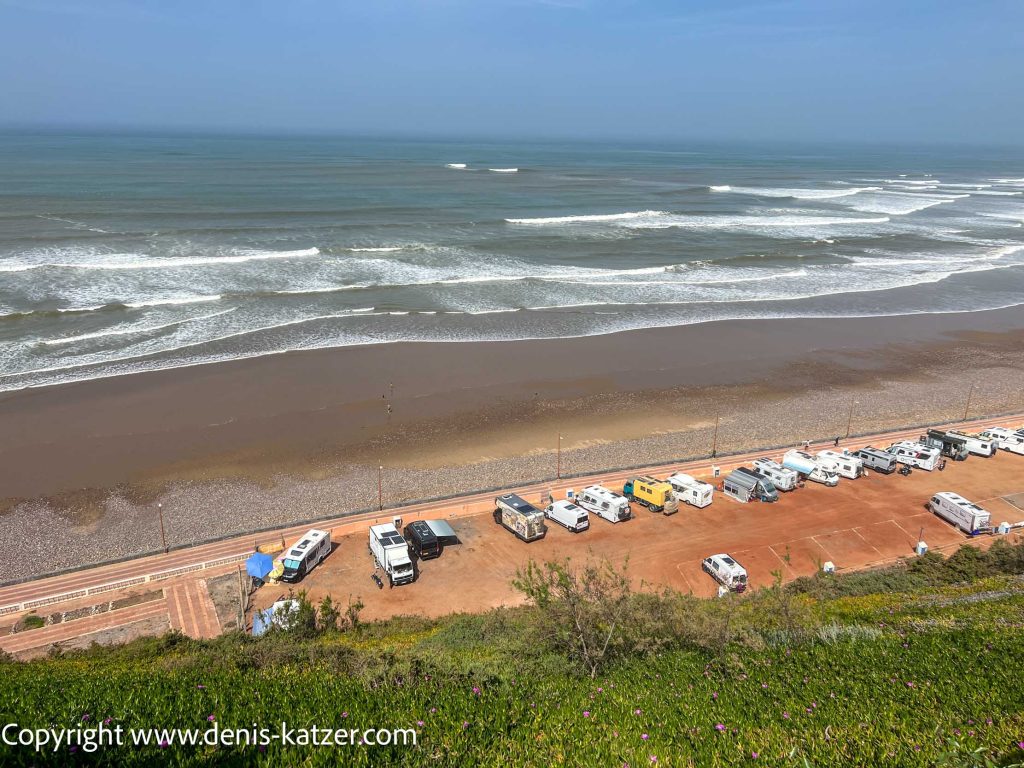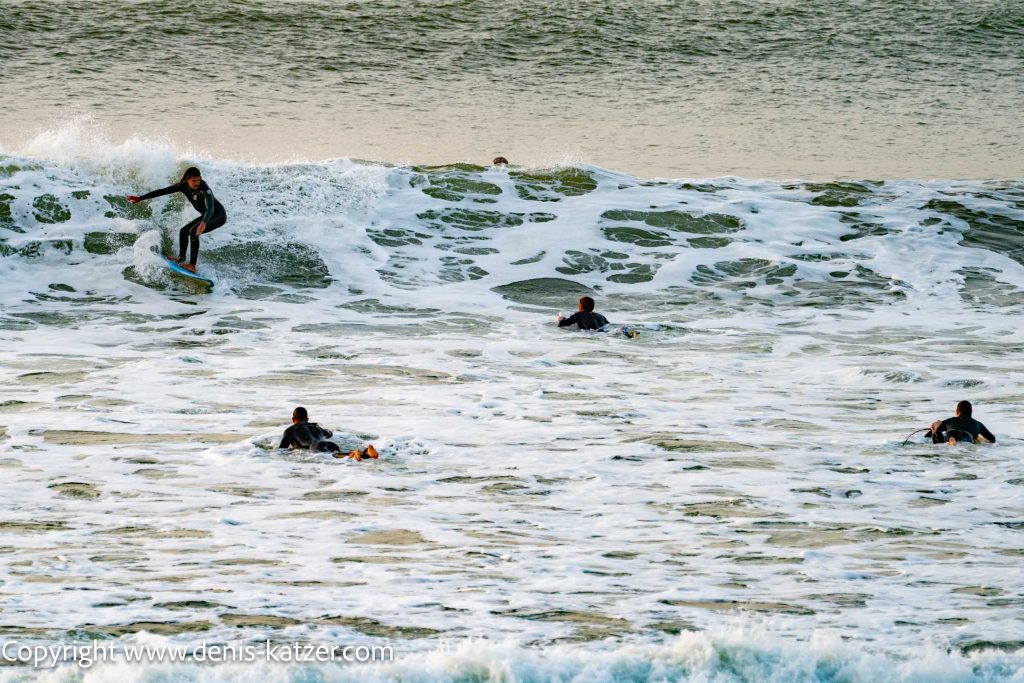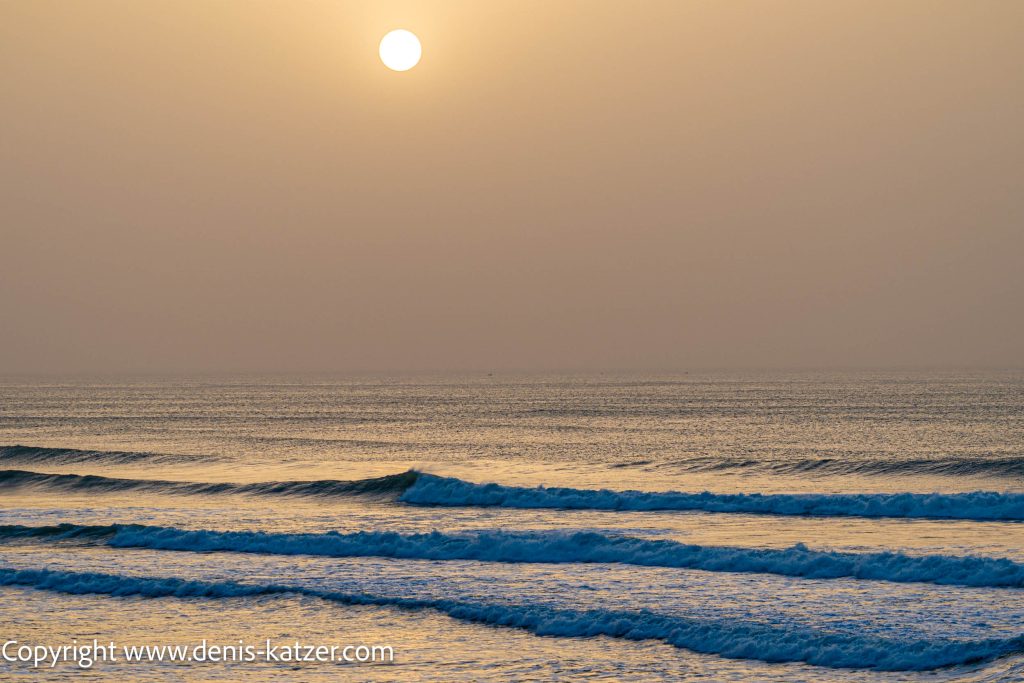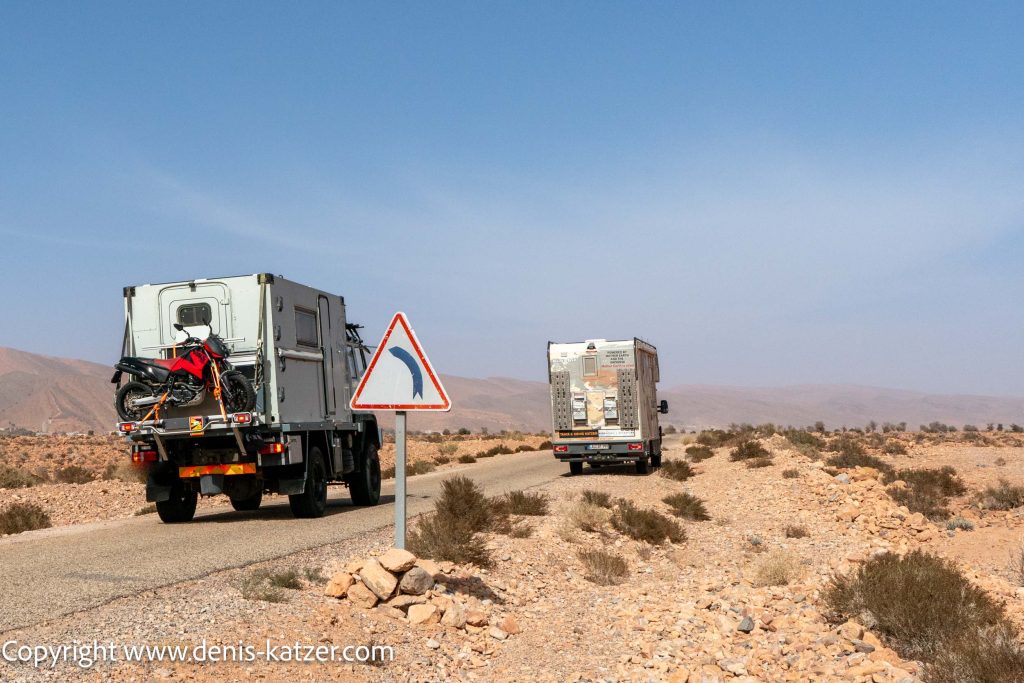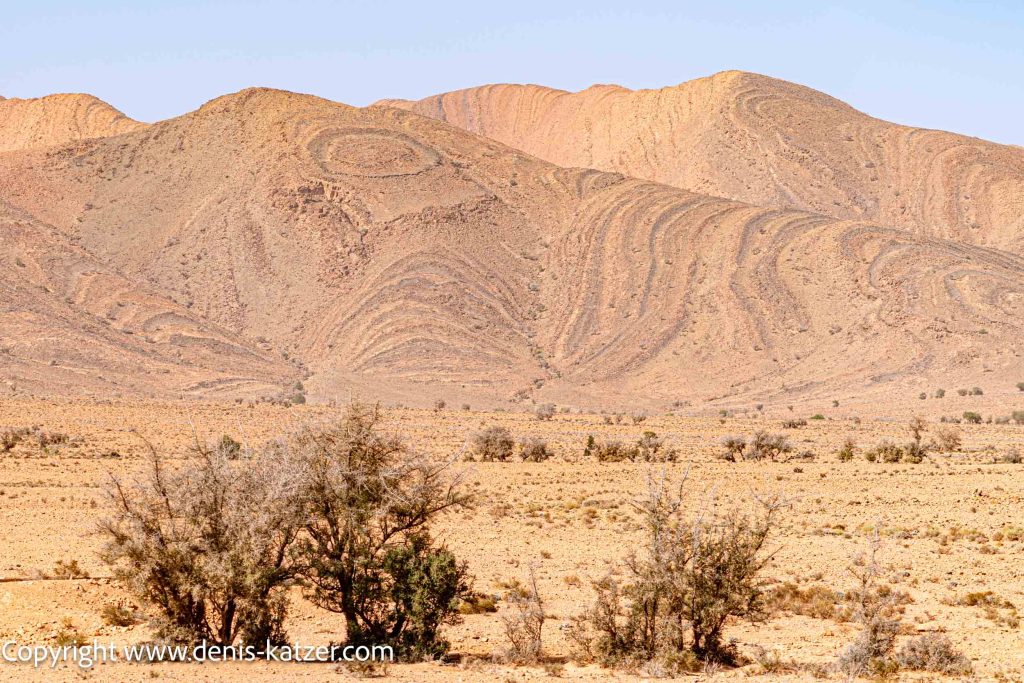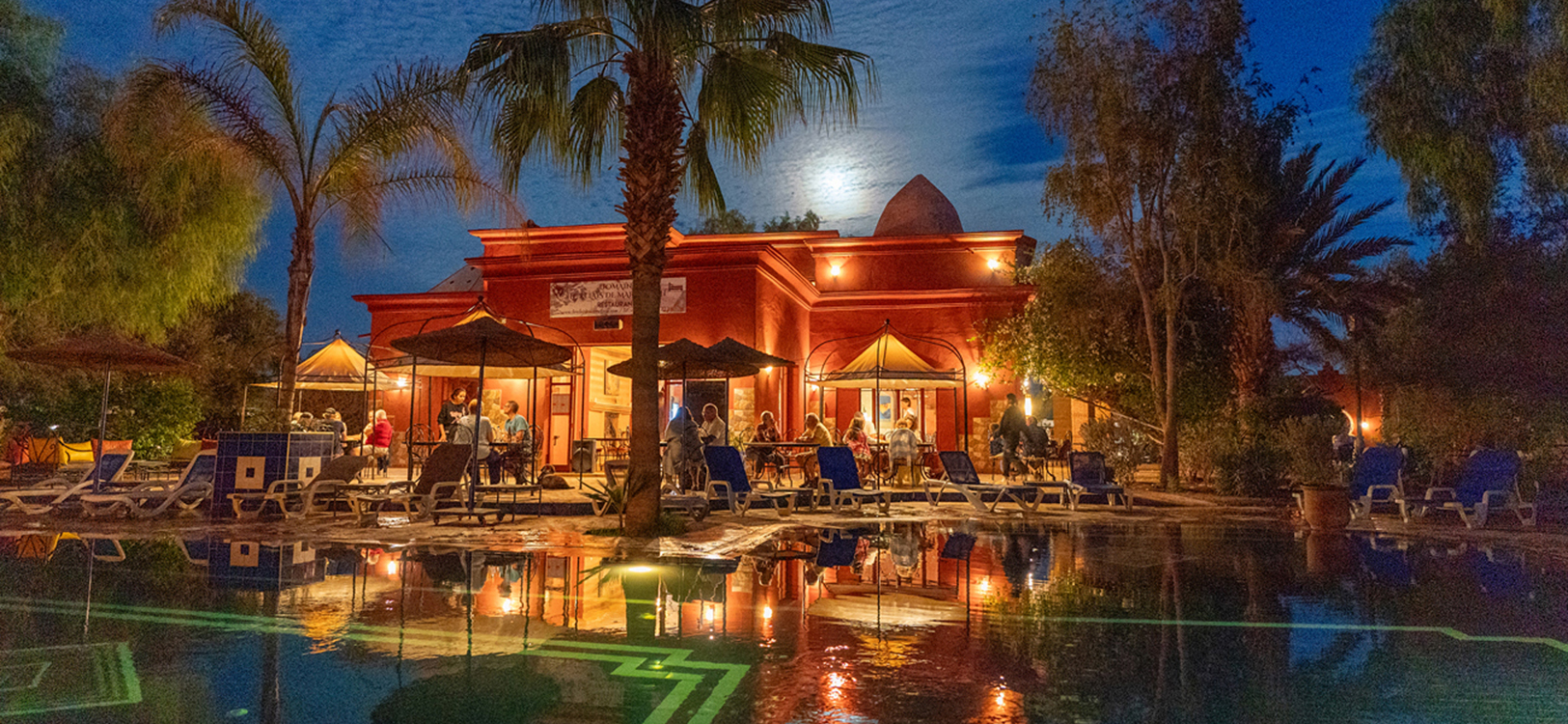
From the Sahara to the Atlantic coast
N 29°22'57.6" W 010°10'34.9"
Day: 02/17/2024
Day: 442
Camp 80
Country: Morocco
Location: Sidi Ifni Camping el barco
Latitude N: 29°22’57.6″
Longitude W: 010°10’34.9″
Total kilometers: 11,831 km
Height: 10 meters
Temperature day max: 19°
Night temperature: 17 °
After leaving the town of Guelmin, also known as the “Gateway to the Sahara”, behind us, we head north to the town of Sidi Ifni, located in the Anti-Atlas Mountains and on the Atlantic Ocean. As almost always in southern Morocco, we are fascinated by the route, which takes us through a region with a rich history and breathtaking scenery. The well-maintained N12 national road is in excellent condition, allowing us to enjoy the drive.
The sometimes barren desert landscape passes us by, but the unique argan trees appear again and again, lending the surroundings a splash of green. These trees, whose oil is prized worldwide, have an impressive life expectancy of 150 to 400 years. They can be recognized by their characteristic rough, netted and cubic “snakeskin” bark as well as their narrow, elongated or elliptical, thick and waxy leaves.
Along the coast, you can observe a variety of wildlife, including different species of birds, sea turtles and, with a bit of luck, dolphins. There is even a legend about a wise old man who was known as the guardian of the argan tree. He is said to have imparted knowledge about the many benefits of argan oil to the people of the region. The guardian of the argan tree is often seen as the guardian spirit of the trees and it is said that he appears in times of need to protect the trees from destruction.
Between the dry desert valleys, the Anti-Atlas Mountains rise again and again, stretching for around 500 kilometers from the Atlantic coast to the city of Ouarzazate. The mountains were formed around 300 million years ago and consist of Precambrian rocks, which are among the oldest known rocks on earth and may be up to 4 billion years old. The highest peak is the Jebel Siroua at an impressive 3,304 meters. The region is characterized by diverse landscapes, including rugged rock formations, fertile valleys and a rich fauna, which is also home to Barbary macaques. The Anti-Atlas Mountains are home to many Berber tribes, who are known for their handicrafts and traditional ways of life. Historical sites such as the rock carvings of Ait Ouazik and picturesque places like Tafraoute are on our Moroccan bucket list.
We reach the charming coastal town of Sidi Ifni, named after Sidi Mohammed Ben Abdallah, a local saint. From 1934 to 1969, Sidi Ifni was a Spanish enclave, which had a formative influence on its architecture and culture. Numerous Art Deco-style buildings and street names in Spanish bear witness to this colonial past. Sidi Ifni was officially returned to Morocco in 1969, but traces of the Spanish presence are still visible today. As in almost every city we have visited on our trip to Morocco so far, we stroll through the souks, which are a window into the rich culture, history and religion. The smell of freshly slaughtered camel meat and the scent of fresh spices and herbs fill the air. Before we drive back to the campsite in our Terra Love, we stock up on fresh fruit and vegetables from the surrounding region.
The souks are not only a place of trade, but also a social hub where locals come together to exchange news and share stories.
Sidi Ifni is a melting pot of different cultures, including Berber, Arab and Spanish.
This cultural diversity is reflected in the local cuisine, traditions and everyday life.
At the end of our short tour through the pleasant little town, we visit the fish market, which is a central trading place for the local fishing industry and an important source of income for the town.
Fresh fish and seafood are caught daily by local fishermen and sold at the market.
There is a wide variety of seafood on offer, including tuna, sardines, mackerel, squid and lobster.
After a relaxing afternoon in the town and the souk, we arrive at the popular El Barco campsite on the picturesque Atlantic coast.
It offers an ideal location right on the beach, at the foot of the town.
The campsite is well equipped and offers amenities such as clean sanitary facilities, showers, electricity connections and a disposal station for motorhomes.
In addition to pitches for tents, caravans and motorhomes, there are also bungalows and rental accommodation for travelers without their own camping equipment. In the evenings, we sit on the roof of our Terra Love and watch the surfers and wave riders.
The waves here are simply fantastic and offer something for everyone – whether beginner or advanced. Especially from September to April, the conditions are perfect, with consistent and high-quality waves. The water temperatures are between 16°C and 22°C all year round, temperatures at which it makes sense to pack a wetsuit. The main beach of Sidi Ifni is a dream: long, wide stretches of sand with beach breaks and point breaks. Beginners can practice here in gentle waves, while the more experienced surfers will find more powerful waves in less crowded areas. There are several surf schools offering lessons and equipment rental. We find the surfing scene here to be incredibly relaxed and friendly.
During our one-week stay in Sidi Ifni, we repeatedly take the opportunity to walk along the wonderful beach. We are often accompanied by the wild dogs that live here. Some of them don’t let up and follow us for long distances, always hoping to find a new, better home. In many coastal regions of Morocco, including Sidi Ifni, wild beach dogs are a well-known phenomenon. These stray dogs are often descended from domestic animals that have been abandoned or left behind and have adapted to life in the wild. They usually live in packs and are often active at night, searching for food and a safe place to sleep. Wild beach dogs are usually shy and avoid contact with humans, but can become more trusting if they are fed regularly. In some cases they can become territorial or aggressive, especially if they feel threatened or food is at stake. Many of these dogs suffer from health problems such as malnutrition, skin diseases or parasites, so it is important to be careful to avoid the risk of diseases such as rabies. In some Moroccan cities and municipalities, animal welfare organizations take care of the castration, vaccination and care of stray dogs in order to humanely control the population. However, resources are often limited.
Feral dogs can have both positive and negative impacts on the local environment. They help to reduce litter and waste by eating edible scraps, but can also pose threats to wildlife. In tourist areas, they are both an attraction and a potential problem, depending on how they behave and how visitors interact with them. Through our daily visits, Tanja and I have gained the trust of the pack of dogs and made friends with them. They quickly got used to our presence. Fresh drinking water and a bowl of dog food make this hot and windy day more bearable.
After a wonderful and relaxing week in Sidi Ifni, we continue our journey into the Anti-Atlas Mountains with its mysterious granary castles and green oases. Thanks to the mild climate, Sidi Ifni is an attractive destination all year round. The temperatures are moderate and the fresh sea breeze creates a pleasant atmosphere. After several months in the Sahara, which is plagued by sandstorms, the mild weather is particularly good for us. The town’s economy is mainly based on fishing and agriculture. The active fishing port supplies fresh fish and seafood, which is an important part of the local cuisine. Sidi Ifni also has a vibrant artistic community. Many local artists and artisans produce traditional Berber art, textiles and ceramics. Craft markets and exhibitions are held regularly, attracting visitors.
Sidi Ifni is a place full of history, culture and breathtaking landscapes that left a deep impression on us. From the stories and legends of the Anti-Atlas Mountains to the daily encounters with the diverse wildlife and wild dogs, every experience has enriched our journey. Now we are excited about the further adventures that the Anti-Atlas Mountains have in store for us and look forward to delving even deeper into this fascinating region of Morocco
Here is the link to the video:
